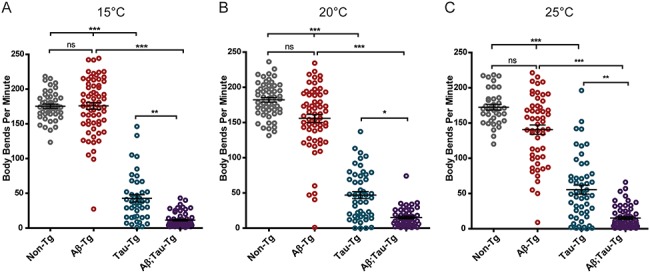Figure 1.

Aβ1-42 and tau neuronal co-expression exacerbates motility defects in C. elegans model as compared to tau expression alone. Staged L4 worms were either kept at 15°C (A) or temperature upshifted for 24 h at 20°C (B) or 25°C (C) to upregulate Aβ1-42 and then subjected to a swimming assay video captured for 1 min swimming duration. Videos were analyzed by automated WormTracker software to count the number of body bends per minute. Aβ1-42-Tg worms showed a similar body-bend mean (175.9 ± 5.0 SEM) to the mean of non-Tg worms (175.4 ± 3.0 SEM) at 15°C, but trended toward reduced body-bend means at 20°C (Aβ1-42-Tg: 155.8 ± 5.8 SEM; non-Tg: 182.2 ± 3.2 SEM) and 25°C (Aβ1-42-Tg: 140.6 ± 6.6 SEM; non-Tg 172.5 ± 4.0 SEM) as compared to non-Tg worms. tau-Tg worms had consistently lower body-bend means at all three temperatures (42.7 ± 5.3 SEM, 46.9 ± 4.9 SEM and 55.46 ± 6.4 SEM at 15, 20 and 25°C, respectively) compared to non-Tg controls. Aβ1-42;tau-Tg demonstrated the lowest body-bend means at all three temperatures (11.5 ± 1.3 SEM, 15.2 ± 1.9 SEM, and 15.2 ± 2.0 SEM at 15, 20 and 25°C, respectively). (N = 2, n ≥ 38, Kruskal–Wallis ANOVA, post hoc Dunn’s comparison. Error bars represent SEM. *P < 0.05, **P < 0.01, ***P < 0.001).
